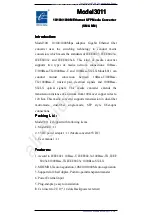
Page 43
The linked state also impacts the Pan controls. If one pan pot is moved to the left the other will move a corresponding amount to the
right. For instance, if the left pot is set to -25, the right channel will pan to +25.
Linked is the default state for pairs of inputs. To “un-link” a pair, click on the link icon and it will change to a single circle:
. In
this state, the mute, fader and pan controls operate on a single channel independently.
y
Input Label
This identifies the Input that is applicable to the fader, pan, mute and input select controls.
The MONITOR page can be used to create complex headphone mixes for an artist, allow mirroring of play streams to multiple
outputs, even send completely different source material to different speaker pairs. Here are some visual examples of routing
configurations that are possible:
In this example, the selected output is MONITOR OUT. We are sending
signal from Play 1+2, existing tracks from a multi-track session.
In addition we are sending signal from the LINE INPUT left channel. The
Line Inputs were “un-linked”, and only the left channel is un-muted, so signal
is passing only from the left channel. Note, that the pan position for LINE IN
left is in the center, so the source will be heard equally through both channels
of the MONITOR OUT.
The Play 1+2 streams are at zero attenuation, as is the Line In. Monitor Out is
attenuated by 29dB.
This would be a common configuration for overdubbing into a project.
In this example, four stereo stems are sent from the
DAW to the PHONES out.
The PHONES level is attenuated by 34dB. The stems
also have varying levels, Play 1+2 is attenuated by 18dB,
Play 5+6 by 11dB, whereas Play 3+4 and 7+8 are at
unity
Here, all of the channels are linked as stereo pairs. Keep
in mind, the settings in the Input row are relative to the
Output selected. If Line Out is selected, the mute states,
fader positions and channel link status of the input
devices would be completely different.
















































